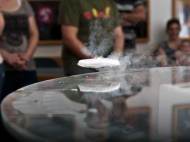Superconductors locked in a magnetic field exhibit quantum levitation
 Although it has been around for a while now, quantum levitation is always interesting to observe. Researchers from Tel-Aviv University recently exhibited their Quantum Levitation project at the ASTC Annual Conference. The project involves usage of superconductivity which enables materials to become strongly diamagnetic – a property which allows them to create an equally opposing magnetic field which enables it to levitate near a magnet.
Although it has been around for a while now, quantum levitation is always interesting to observe. Researchers from Tel-Aviv University recently exhibited their Quantum Levitation project at the ASTC Annual Conference. The project involves usage of superconductivity which enables materials to become strongly diamagnetic – a property which allows them to create an equally opposing magnetic field which enables it to levitate near a magnet.
Once a material is exposed to extremely low temperatures (which vary depending on the used material) it becomes superconductive – a state that allows a material to become diamagnetic and posses zero resistance to low applied currents when there is no magnetic field present or if the applied field does not exceed a critical value.
Scientists around the world have been trying to find materials suitable for the real world application of this phenomenon, but the closest findings thus far led to a material which is superconductive at the temperature of -135°C (138°K or -211°F). Lead by Prof. Guy Deutscher, one of the leading physicists in the field of superconductivity, the Tel-Aviv University researchers are trying to discover the yet unknown mechanism of superconductivity in high temperature superconductors. In meantime, they demonstrate amazing properties of superconductors such as quantum trapping and quantum levitation.
They used a thin superconductor layer (~1µm thick) of ceramic material called yttrium barium copper oxide (YBa2Cu3O7-x) to coat a single crystal sapphire wafer. In order to protect these layers from breaking and needed treatment, they were additionally coated with a layer of gold and closed with a plastic wrap. The ceramic layer has no interesting magnetic or electrical properties at room temperature, however, once cooled below -185ºC (88°K or -301ºF) the layer becomes a superconductor.
Although we recently wrote about a research in which scientists created a material capable to have both superconductive and magnetic properties, these properties haven’t been found to coexist in nature. Naturally, the superconductor expels all the magnetic field from inside (Meissner effect).
Since the superconductor is extremely thin the magnetic field does go through it in discrete quantities called flux tubes. Inside each magnetic flux tube superconductivity is locally destroyed. The superconductor strongly pins these tubes, causing it to float in mid-air. Any spatial movement of the superconductor will cause the flux tubes to move and leave it perform quantum levitation along the magnetic field.
The technology has promising future applications in energy and transport industries, as well as development of new composite materials, but it also has a few drawbacks that need to be addressed before we witness its widespread use. Aside the fact we need extremely low temperatures to make a material act as a superconductor, superconductors are sensitive to moving magnetic fields, making them harder to develop for operation alongside alternating current.









author
You can watch another interesting video the research group has posted:
http://www.youtube.com/watch?v=VyOtIsnG71U
I’m praying that the gods or aliens watching over us will send me the formula, possibly in a dream, for a material that becomes a superconductor at 98.6 degrees F. Until then, or if there are no aliens or gods, I’ll keep tinkering with my own crazy science fiction ideas.
Once I get a room temperature superconductor I will have a material more suitable for creating a bio-electromechanical interface to connect to the human brain.
Then I can download all of my memories, personality and entire brain contents onto a digital storage media for future upload into the brain of my clone.
My backup plan is to have my body held in a state of suspended animation, through cryonics, at Alcor Life Extension Foundation out in Scottsdale, AZ.
Respectfully Submitted,
ROBERT F CRUNK